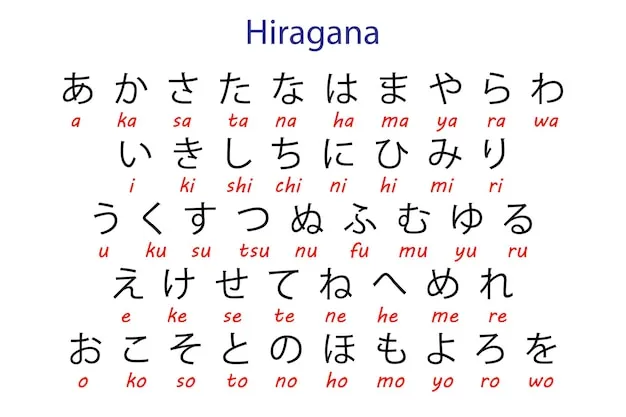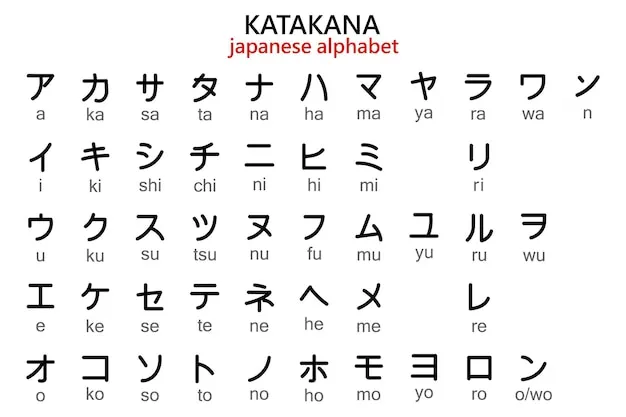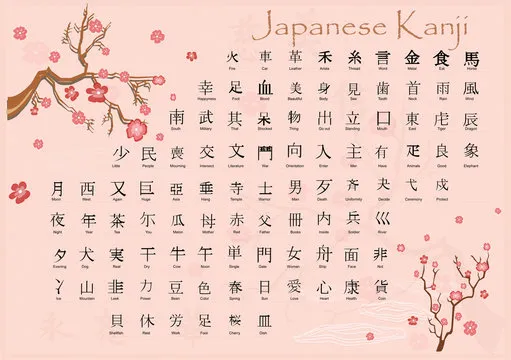Learning any language is intimidating initially, but more so Japanese. Japanese writing is perhaps one of the most important skills you can learn in Japanese. Writing involves constructing your sentences using all of the Japanese words and grammar you have learned so far. Japanese writing practice has a lot of benefits, including learning important skills of self-discipline and memory. It will be easy to learn any other language after you have mastered Japanese. Your memory as well as your concentration increases as your Japanese vocabulary expands. Learning Japanese writing also acquaints you with the rich culture of Japan. Additionally, it is one of the most successful economies, and if you are planning on relocating there, understanding the Japanese language and vocabulary will greatly help you in such an endeavour. This article will guide you on how to boost your writing prowess in this beautiful language.
The Japanese Alphabet
The Japanese System Of Writing is three writing systems combined. These three systems are hiragana, katakana, and kanji. Hiragana and katakana are simpler to learn and useful if you want to learn basic Japanese. Learning kanji is more complicated. Hiragana and katakana are two different styles of writing the same forty-six sounds. This type of writing system is more accurately described as a ‘syllabary’ rather than an “alphabet”. Characters are semi-syllabic and mostly represented in their whole form as a sound, like ‘ki’ or ‘ra’, not a single letter (like ‘k’ or ‘r’). Usually, we write native Japanese words using hiragana, but use katakana to write words that are borrowed from other languages. For instance, arigatou, the Japanese word for “thank you”, is generally represented in hiragana with the characters ありがとう (a ri ga to u), whereas America will be represented using the katakana system with the characters アメリカ (a me ri ka)

Learning Hiragana in Japanese Writing
Hiragana is the core part of the Japanese language, and it is used to construct the majority of the sentences. It helps you learn basic pronunciation in Japanese and gets you started with an understanding of how the language works. Hiragana characters are the 46 primary sounds used in Japanese. The characters are noted by the consonant they start with and the vowel that follows. The vowel order used in learning Japanese is a (ah), i (ee), u (oo), e (eh), o (oh). To learn them, you need to start by just laying it all out on a piece of paper and try remembering them by the stroke order from the beginning. This stroke pattern memorisation will aid you in your development through Japanese Writing Practice. A smart way to memorise is to write one character down at least 15 to 20 times, so it will be impossible to forget the pattern.

Learning Katakana in Japanese Writing
Learning Japanese katakana is like getting an insight into the history of the language itself. Luckily, the character set of katakana incorporates the same sounds as hiragana. Some characters even look very similar. And there is not much difference between the pronunciations of hiragana and katakana words. But the main distinction is in their writing styles. Fewer round shapes and more straight lines define katakana instead of hiragana. Learning Japanese hiragana first is always a good way to start your Japanese Language writing before moving on to katakana and kanji. Since you are accustomed to the general style of Japanese writing, katakana takes much less time to memorise and learn.

Learning Japanese Kanji
Unlike katakana and hiragana, kanji are not always characters you have strung together to make sounds and words. Kanji are symbols — they represent a whole word or an idea. Most of them were borrowed from Chinese characters at different periods over the last few centuries. There are over 6,000 kanji! But you will notice that Japanese language writing usually uses approximately 2,000 kanji characters. Memorisation is the most effective method for learning these, just like hiragana and katakana. This can be coupled with flashcards, making your memory retention probably much higher compared to other modes of learning and also breaking the monotony. It is easier to focus on the meanings of certain words in kanji than to try to remember how to read them. This is because most kanji characters generally have more than one pronunciation depending on how they are used.

Here Are Some Tips to Improve Your Japanese Writing Skills
Mugging the language alone is not the way to learn it well. This is because the onus lies in making sure you get the basics right to be a Master of the Japanese Language. Start slow, five characters is a good number to start with per session. At the beginning, you will find it difficult to memorise everything. However, the more you practice writing in the Japanese language, the better you will become.
- The Right Stroke Order: This is practically the rule of thumb in Japanese writing practices. It is to make sure that you will never go wrong. Even if the writing is a little sloppy, the stroke order makes them legible and right in pattern.
- Write Within Boxes: Try using graph paper instead of your normal ruled sheets to start with. It helps to keep things inside the box, working on correct strokes and patterns.
- Write Big & Slow: Be bold and write in big letters. You need not be good right from day one. However, you will need to be accurate. Slowly, and with precision, is the way. You can progressively reduce the character size as you go up the scale of achievement.
- Characters in Your Face: Make large cut-outs or prints of the Japanese characters you are learning and place them on a board right in front of your eyes. Make sure you have the most accurate representation while practising on your own.
Online Japanese Language Learning
To become a Japanese language expert, you need to master the language from scratch to the top level. You must understand the Japanese language alphabet, grammar, accent, pronunciation, sentence formation, to paragraph writing. In a nutshell, master the language to confidently write and fluently speak Japanese.
To have command over the Japanese language, you must pursue the Japanese Language Courses from Kazumi Japanese & Culture School. It is the topmost Japanese Language Academy. Online learning and quality training by Language experts have attracted numerous language professionals and learners from various national and international locations. Numerous students are seeking careers in the Japanese language. They look for Online Japanese language Courses to master their writing and speaking skills in the Japanese Language. Successful completion of the course up to an advanced level will boost confidence to write and speak Japanese. Moreover, you will get high-paying job opportunities in top organisations.
Kazumi Japanese & Culture School
Kazumi Japanese & Culture School is the No.1 Japanese Language School. The academy is renowned for its high-quality education and rigorous standards of learning and teaching. We provide the latest online Japanese Language Courses for proficiency in the Japanese language, including written and spoken skills. You can learn Japanese from the elementary level N5 to the advanced level N1. Master the language and grab your dream job!
Kazumi Japanese & Culture School is promoting Japanese Language Online learning PAN India, UK, US, the Middle East, and Australia. Numerous learners, language passionate and Japanese Language professionals from different locations, pursue our Online Japanese Language Courses. Online Learning option with timing flexibility opens learning opportunities for numerous students. You can simply boost your Japanese Language skills along with your regular commitments. This will enhance your confidence to perform efficiently and accurately.
Japanese Language Expert Trainers
At Kazumi Japanese & Culture School, we provide professionally qualified and language-expert trainers. Our faculty delivers quality Japanese Language Training with clear Japanese language concepts, pronunciation and grammar. The motive is to train every student Japanese language from scratch to an expert level.
Professionals who want to build a career in the Japanese language and are open to working at an international level look for expertise in the Japanese language. Exploring the best Japanese Language Academy can be a life-changing decision, especially when the institute goes beyond just teaching vocabulary and grammar.
Live Projects and Internships
Kazumi Japanese & Culture School is the top academy where you can master your expertise in the Japanese Language. Our Online Japanese Language Course is a two-way live interactive session. There are facilities to undertake projects in the Japanese language.
Kazumi Japanese & Culture School also provides internships that help students get a better understanding of the language. Access to abundant tools and video content.100% placement, Government-recognised certificate, and boot camps throughout the one-year post-completion of the course. One-year gold membership for the Japanese Language Training course.
Placement Support
Kazumi Japanese & Culture School is ranked No.1 Japanese language school offering a comprehensive online learning experience, combining language mastery with dedicated job placement support to get better work opportunities.
Fluency and expertise in the Japanese language will open the door to language expert job roles in top organisations. Key areas for career opportunities include Japanese language translation jobs, tourism, international trade, top Japanese language academies, and Japanese MNCs where expertise in the Japanese Language is preferred.
Kazumi Japanese & Culture School offers more than 10+ job offers weekly, and experiences industry-level projects during the training.
Turn Japanese Language Skills into Top Job Opportunities!
Eduwatts
Another top-level educational organisation is Eduwatts. The institute is known for quality education and the latest online courses, such as Japanese Language. All courses are regularly updated with the latest curricula. The course content is well aligned with the industry demand and requirements. Thus, makes every student skilled to work efficiently on the latest technology, application or software.

Eduwatts, a brand of Crestwood Solutions, offers programs from outside the United States and India. Such international presence affirms that whatever programs they introduce have diverse global perspectives with best practices suited to varied demands in education worldwide. Eduwatts brings world-class learning to its programs. The Watts faculty has experience of over 15 years and has honed their unique methodologies and distilled their expertise into the ‘Watts’ approach. The fact that their alumni are well-recognised individuals in various fields all over the world speaks of the quality and effectiveness of Eduwatts. Becoming part of a thriving community of successful professionals is what EduWatts offers.
Let us explore online Japanese Language Learning from Eduwatts.
Japanese Language Course- N1 Level
This Japanese Language Course- N1 Level at Eduwatts is the entry level to the Japanese Language Proficiency Test. It targets absolute beginners. This course teaches the basics of grammar, vocabulary, and kanji to help learners deal with simple conversations and Japanese writing. Through this course, you will be well prepared for the Japanese Language Proficiency Test, JLPT N5. The course is used by enthusiastic novices to get them ready for the goal of being fluent Japanese speakers.
Conclusion
Buy a beautiful notebook and determine how many hours you will spend on your journal. If you are a beginner, start with a few hours per week and gradually increase the hours as time goes on and you enjoy it. Set some simple challenges for yourself to improve your Japanese writing. This will assist you in keeping yourself interested and focused. Generally, learning a new language takes patience, commitment, and perseverance. Without these three, the world’s best experts will fail to teach you even the basics.
Recommended Reads
- Best 10 Japanese Language Courses in Bangalore
- Online French Language Courses: Pros and Cons
- Future Scope After the German Language Course in India
- The Best Online Mandarin Language Courses: Flexible Learning Options
FAQs
Q1. Can one learn Japanese entirely from the internet?
Ans. The internet can help you enhance your knowledge and learn the characters and words practically. Having Japanese friends or looking for language exchange partners (where you exchange languages) would also enhance the learning process.
Q2. Is it important to use the right strokes in forming characters when writing?
Ans. In Japanese, order and direction are important. Every letter in the Japanese alphabet is created with a sequence of strokes or lines. There are horizontal, vertical, diagonal, and others types, which have to be drawn correctly.
Q3. Are there any good books available to help you learn Japanese writing?
Ans. Two books recommended by experts are:
1. Learning Japanese Hiragana and Katakana: A Workbook for Self-Study
2. Japanese From Zero
Q4. How long does it take to complete the Japanese Language Course- N5 Level course?
Ans. The duration of the Japanese Language Course- N5 Level can vary depending on the provider and the learner’s pace. In Eduwatts, the course will be completed in 98 Hours. The hours are regulated in accordance with the specific batch chosen.
Q5. Does Watts Education offer a certificate when completing the N5 Japanese level course?
Ans. Yes, when you complete a course in the N5 Japanese level, Eduwatts will issue an industry-recognised certificate. The certificate is proof of commitment and professionalism.


